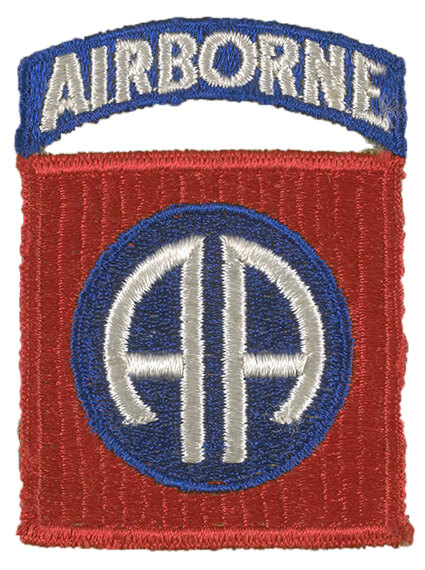| Page Created |
| August 16th, 2024 |
| Last Updated |
| August 16th, 2024 |
| The United States |
 |
| Additional Information |
| Unit Order of Battle Commanders Operations Equipment Multimedia Sources Biographies |
| Badge |
 |
| Motto |
| All American |
| Founded |
| March 25th, 1942 |
| Disbanded |
| – |
| Theater of Operations |
| Sicily, Italy Naples-Foggia, Italy Rome-Arno, Italy Normandy, France |
| Organisational History |
Being already in existence, but in reserve, at the beginning of World War 2, the transformation of the 82nd Division begins on February 13th, 1942, when it is redesignated as Division Headquarters, 82nd Division. This marks the beginning of its evolution into a specialised airborne unit. Shortly thereafter, on March 25th, 1942, the division is ordered into active service at Camp Claiborne, Louisiana, under the command of Major General Omar N. Bradley. The division’s officer and enlisted cadre are drawn primarily from the 9th Infantry Division, with additional enlisted personnel recruited from reception centres across the Midwest, South, and Southwest regions of the United States. During this formative period, the division unites three officers, Matthew Ridgway, James M. Gavin, and Maxwell D. Taylor, who will later play pivotal roles in shaping the U.S. Army for decades to come. Under Major General Bradley, the division’s Chief of Staff, George Van Pope, also makes significant contributions to the division’s early development.
| Transformation to Airborne |
A significant milestone is reached on August 15th, 1942, when the 82nd Infantry Division is redesignated as the 82nd Airborne Division, becoming the first airborne division in U.S. Army history. This transformation is the result of careful deliberation by the U.S. Army General Staff, who select the 82nd Division for several reasons. Unlike many other units, the 82nd is neither a Regular Army nor a National Guard division, making it more suitable for conversion into an experimental force. Additionally, its personnel have all completed basic training, and its location offers favourable weather and flying conditions, both critical for airborne training.
Initially, the 82nd Airborne Division comprises the 325th, 326th, and 327th Infantry Regiments, along with supporting units. However, as the war progresses, the division undergoes further changes. The 327th Infantry Regiment is transferred to help form the 101st Airborne Division and is replaced by the 504th Parachute Infantry Regiment, shifting the division’s composition to include two regiments of glider infantry and one of parachute infantry. In February 1943, the 326th Infantry Regiment is also reassigned, this time to the 13th Airborne Division, and is replaced by the 505th Parachute Infantry Regiment, under the command of then-Colonel James M. Gavin, who will later command the entire division.
In April 1943, the men from the 82nd Airborne Division, now under the command of Major General Matthew Ridgway, leave for the Mediterranean Theater of Operations. This marks the division’s first significant overseas assignment during World War II.
The 82nd Airborne Division lands at Casablanca on May 10th, 1943, where it undergoes intensive training in preparation for its first combat operations. The division’s baptism of fire comes in July 1943 during the Allied invasion of Sicily. On the nights of July 9th and 10th, 1943, the 505th Regimental Combat Team (RCT) and elements of the 504th Parachute Infantry Regiment make a daring drop behind enemy lines near Gela. The remainder of the 504th Regimental Combat Team follows on July 11th-12th, 1943, also landing near Gela. Despite facing disorganised landings and friendly fire from naval and ground forces, the paratroopers regroup, forming cohesive units that engage the enemy as ground troops.
After the initial battles in Sicily, these elements are flown back to Tunisia for reequipment before returning to Sicily. From there, they launch a crucial operation—a series of drop landings on the Salerno beachhead as part of the Allied invasion of mainland Italy.
On September 13th, 1943, the 504th Parachute Infantry Regiment makes its drop onto the Salerno beachhead, followed by the 505th the next night. The 325th Glider Infantry Regiment lands by boat, reinforcing the paratroopers on the ground. These combined forces play a vital role in bolstering the Salerno defences, holding the line against fierce German counterattacks. They then push forward, fighting their way into Naples by October 1st, 1943, securing this key port city for the Allies.
Following the capture of Naples, the division undertakes occupation duties, with some elements continuing to see combat in the Volturno Valley and at the Anzio beachhead. In November 1943, the division is moved to Ireland, and later to England in February 1944, where the 82nd Airborne Division is thrust into the heart of the Allied invasion plans. On February 19th, 1944, the division is attached to the VIII Corps, but remains under the command of the First Army. This period is marked by intense preparation as the division, now a seasoned airborne force, readies itself for its role in the upcoming invasion of Normandy.
By March 13th, 1944, the 82nd Airborne Division is firmly integrated into the VIII Corps, First Army. However, as D-Day approaches, the division is reassigned on June 6th, 1944 to VII Corps, positioning it at the forefront of Operation Overlord. Dropping behind enemy lines in Normandy, the division’s glider and parachute troops are tasked with cutting off German reinforcements and securing key positions before the main amphibious assault. Over the next 33 days, the division fights its way from Carentan to St. Sauveur-le-Vicomte, engaging in relentless combat without relief. Their efforts are crucial in disrupting German defences and securing the success of the Normandy invasion. During this period, the 82nd Airborne Division is repositioned under the VIII Corps on June 19th, 1944, as the Allies consolidate their gains and push deeper into France.
On July 8th, 1944, after more than a month of continuous fighting, the division is finally relieved and returns to England for much-needed refitting and rest.
On July 13th, 1944, the division is briefly attached to the Ninth Army, reflecting its expanding role in the Allied advance across Western Europe.
By August 12th, 1944, the 82nd Airborne Division is once again reassigned, this time to the XVIII Airborne Corps under the First Allied Airborne Army. This reassignment positions the division to be a key player in future airborne operations, as the Allies prepare for further incursions into German-held territory.
In the autumn of 1944, the 82nd Airborne Division becomes increasingly integrated with British forces. On September 17th, 1944, it is attached to the British I Airborne Corps within the British 21st Army Group, marking its involvement in Operation Market Garden. This ambitious operation aims to secure key bridges in the Netherlands, and the 82nd Airborne Division’s role is crucial in this daring attempt to outflank German defences.
On September 17th, 1944, the division is dropped 80 kilometres behind enemy lines near Nijmegen in the Netherlands. Their objective is to capture the Nijmegen bridge, a critical crossing over the Waal River. After intense fighting, the division successfully captures the bridge on September 20th, 1944, performing the river Waal crossing in little boats. This enables the British 2nd Army to advance and link up with isolated paratroopers further north.
Following this operation, the division continues to engage in heavy combat in Holland until it is relieved on November 11th, 1944, allowing the soldiers a brief period of rest in France.
By October 9th, 1944, the division is transferred to the British XXX Corps, part of the British Second Army, continuing its close coordination with British forces. The 82nd Airborne Division’s adaptability and effectiveness in these multinational operations highlight its strategic value to the Allied cause.
On November 9th, 1944, the division is again reassigned, this time to the Canadian II Corps within the Canadian First Army, still under the British 21st Army Group. This period underscores the collaborative nature of the Allied efforts, as forces from different nations work together to break through German lines.
The winter of 1944 presents one of the most challenging periods for the 82nd Airborne Division. The intended respite is brief, as on December 17th, 1944, the German counteroffensive in the Ardennes, known as the Battle of the Bulge. The division is placed under the VIII Corps of the First Army, 12th Army Group. The very next day, it is again reassigned to V Corps. The 82nd Airborne Division is rushed back into combat to stem the German offensive. On December 19th, 1944, the division returns to the XVIII Airborne Corps, reinforcing the Allied defensive efforts. On December 20th, 1944, the entire First Army, including the 82nd Airborne Division, is temporarily attached to the British 21st Army Group, underscoring the critical nature of the situation as the Allies respond to the German offensive.
As the Allies regain momentum in early 1945, the 82nd Airborne Division continues to be strategically repositioned. On January 18th, 1945, the division remains within the First Allied Airborne Army but is attached to the XVIII Airborne Corps under the First Army, 12th Army Group. This period is marked by preparations for the final push into Germany, with the division poised to play a key role in the closing stages of the war.
In early February 1945, the 82nd Airborne Division breaks through the formidable Siegfried Line, a series of German defensive fortifications along the western border of the Reich. Meanwhile on February 14th, 1945, the division is briefly assigned to III Corps. On February 17th, 1945, the division crosses the german Ruhr River, continuing its relentless advance into Germany. In the midst these operations, on February 19th, 1945, it returns to the First Allied Airborne Army. This reassignment ensures that the 82nd Airborne Division remains at the forefront of the Allied airborne operations as they near victory in Europe.
After a period of training with new equipment in March, the division returns to combat on April 4th, 1945, patrolling along the Rhine River and securing the Cologne (Koln) area.
The division’s final major reassignment comes on March 31st, 1945, when it is attached to XXII Corps of the Fifteenth Army, part of the 12th Army Group. The division’s final major operation comes in late April 1945, when it crosses the Elbe River on April 30th, 1945, and advances into the Mecklenburg Plain. On May 2nd, 1945, in this region, the German 21st Army surrenders, marking one of the final acts of the war in Europe for the 82nd Airborne Division. This move marks the beginning of the final phase of the division’s involvement in the war, as the Allies prepare to bring the conflict to a close.
